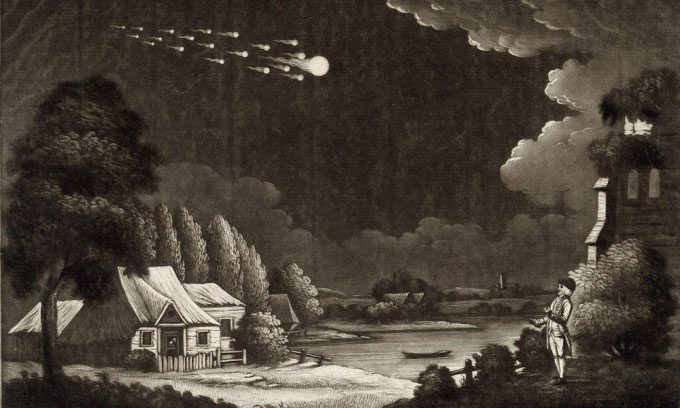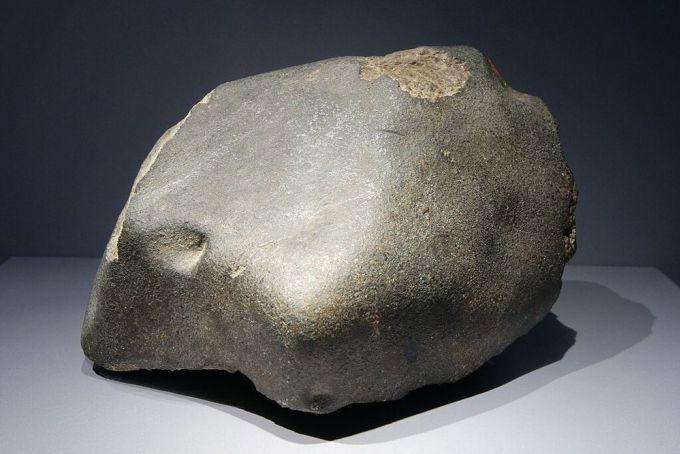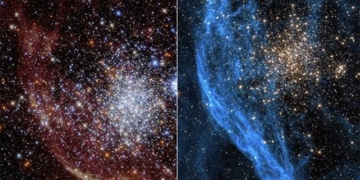The meteor shower that fell on the town of L’Aigle in France in 1803 provided compelling evidence for the existence of extraterrestrial rocks, marking the beginning of the field of meteoritics.
Before the 1800s, scientists remained skeptical about meteorites. Despite historical records of meteorites dating back to Roman times, the idea of rocks falling from the sky seemed implausible to experts of that era. The majority believed they originated from Earth, possibly from volcanic activity, or formed when dust particles in the atmosphere fused due to lightning, as suggested by scientist René Descartes in the 17th century.

Simulation of the meteor shower in 1783. (Image: Wellcome Collection)
In 1794, German physicist Ernst Chladni challenged the prevailing notion and proposed in a book that meteorites originated from outer space. According to Chladni, they were fragments scattered throughout the solar system and never combined to form planets. This could explain why the falling stones descended at high speeds and glowed brightly as they entered Earth’s atmosphere. Chladni also pointed out the correlation between the “fireballs” observed and instances of falling stones, along with the physical similarities of the rocks collected after they fell.
Chladni’s hypothesis sparked controversy as it contradicted the views of both Isaac Newton and Aristotle regarding celestial bodies. His claims also challenged the common belief of the time that, aside from the Moon, there was nothing but stars and planets. Some supported his hypothesis that meteorites came from beyond Earth, while others vehemently rejected it, advocating for alternative explanations involving volcanic activity, chaotic ocean currents, or lightning striking iron ore.
Several years after Chladni’s work was published, astronomers began to make groundbreaking discoveries that lent further credibility to the existence of meteorites in the solar system. In 1801, astronomer Giuseppe Piazzi discovered Ceres, marking the first identification of an asteroid. In 1802, Heinrich Olbers further discovered the asteroid Pallas. In the same year, two chemists, Jacques-Luis de Bournon and Edward C. Howard, closely studied meteorites, finding they had distinct chemical compositions and mineral content different from Earth rocks. These new discoveries gradually reinforced the view that meteorites originated from extraterrestrial sources.
On the afternoon of April 26, 1803, the town of L’Aigle in Normandy, France, experienced a remarkable event as over 3,000 meteorite fragments fell. The French Academy of Sciences quickly dispatched young scientist Jean-Baptiste Biot to investigate this phenomenon. Biot conducted thorough field research, gathering diverse eyewitness accounts, analyzing rock samples from the area, and ultimately providing compelling evidence for the extraterrestrial origin of the falling stones.

A fragment of the L’Aigle meteorite. (Image: Marie-Lan Tay Pamart/Wikimedia Commons).
First, Biot noted that the composition of the stones differed significantly from any local materials but bore many similarities to rocks found in previous meteorite falls. This suggested a shared extraterrestrial origin.
Next, Biot interviewed numerous observers, who independently confirmed that they had witnessed the meteor shower. These individuals came from various backgrounds, and Biot believed they could not have colluded to fabricate descriptions of a non-existent event. Biot’s research affirmed that the stones from the L’Aigle meteor shower had an extraterrestrial origin, marking the beginning of the field of meteoritics.
Today, a fragment of the L’Aigle meteorite, along with another meteorite that fell in France 19 years later, is preserved in a special room at the Muséum d’histoire Naturelle d’Angers, a natural history museum in France. These meteorites serve as tangible reminders of a pivotal moment in the history of science, when skepticism gave way to acceptance, and meteoritics became an established field of study.


















































